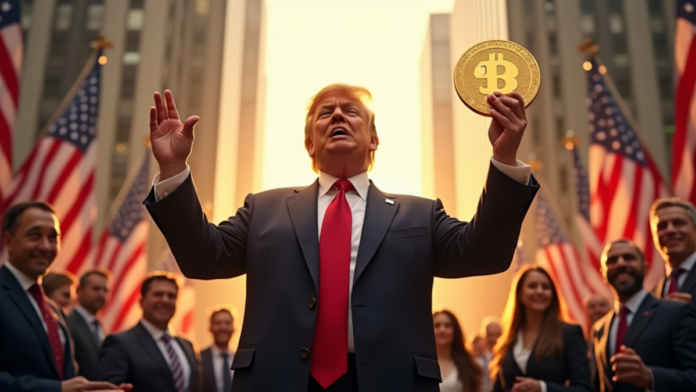
Learn all about USD1, the World Liberty Financial stablecoin backed by Donald Trump. We analyze its impact on digital finance, its advantages, challenges, and how it could revolutionize the cryptocurrency market.
The world of cryptocurrencies never ceases to amaze us, and now, US President Donald Trump's platform seems ready to leave its mark on the sector. The World Liberty Financial (WLFI) platform is preparing to launch USD1, a stablecoin that promises to revolutionize the way we interact with digital finance. But what exactly is USD1, and what implications does its arrival on the market have?
This initiative Not only does it represent a new chapter in Donald Trump's business career, but it also introduces a significant player into the competitive world of stablecoins. Backed by traditional assets, USD1 seeks to offer stability and confidence in an often volatile market. Let's take a closer look at the key aspects of this new cryptocurrency and its potential impact on the future of digital finance.
The launch of USD1 raises expectations and questions. Will it be a resounding success, attracting a large, loyal user base, or will it face regulatory and market challenges that will limit its reach? The answer to these questions depends on several factors, including the marketing strategy, user adoption, and the ability to maintain the promised stability.
What is USD1, World Liberty Financial's stablecoin?
USD1 is a stablecoin, meaning its value is pegged to a more stable asset—in this case, the US dollar. Unlike cryptocurrencies like Bitcoin or Ethereum, which can experience significant price fluctuations, USD1 is designed to maintain a constant value of $1. This makes it a useful tool for everyday transactions, savings, and as a safe haven in the crypto world.
Of course, this new stablecoin will operate within the World Liberty Financial ecosystem, the platform Trump is promoting. This integration could facilitate faster adoption among his followers and users, offering an alternative to traditional financial systems. Imagine being able to pay for goods and services within this ecosystem, or even receive payments, directly in USD 1, avoiding bank fees and delays.
Furthermore, the creation of USD1 raises questions about Trump's vision for the future of finance. Is he seeking to challenge the dominance of existing cryptocurrencies? Or simply find a new way to connect with his base through an innovative financial product? The answers to these questions could define the direction of USD1 and its impact on the market.
Offering the best of both worlds
After all, stablecoins like USD1, in theory, offer the best of both worlds: the stability of fiat money and the efficiency of blockchain technology. This makes them attractive for a variety of use cases, from online commerce to international remittances. The key to USD1's success will lie in its ability to deliver on this promise and offer a superior user experience compared to existing alternatives.
To better understand USD1's role in the crypto ecosystem, it's helpful to consider the concept of "programmable money." Stablecoins enable the creation of smart contracts and decentralized applications (dApps) that can automate and optimize financial processes. In this sense, USD1 could become a fundamental component of the financial infrastructure of the future.
Backed by traditional assets: a guarantee of trust
The key to any stablecoin's success lies in its backing. USD1 promises to be backed by traditional assets, such as cash, government bonds, and other liquid financial instruments. This backing is critical to maintaining the 1:1 peg with the US dollar and ensuring users can convert their USD1 into real dollars at any time.
Transparency in backing is crucial. World Liberty Financial must periodically disclose the composition of its reserves to demonstrate that every USD 1 in circulation is properly backed. Independent audits and public reporting will be essential to build trust among users and avoid the problems that have plagued other stablecoins in the past. But above all, USD 1 must comply with the US Stablecoin Act, which is already under discussion in the Senate.
And this last point is important because let's consider the case of Tether (USDT), the largest stablecoin on the market. Over the years, Tether has faced criticism and scrutiny for its lack of transparency regarding its reserves. This is where USDT has an opportunity to learn from these mistakes and set a higher standard of transparency and accountability from the outset. This could include publishing detailed reserve reports daily or weekly, as well as conducting full audits by reputable firms.
In addition to the type of assets backing the currency, the location and security of these assets are also key. World Liberty Financial could choose to hold its reserves in regulated and insured banks, or even choose to diversify its holdings across different institutions to mitigate risk. Clear communication about these security measures will be vital to building user trust.
It's important to note that backing a stablecoin isn't simply a matter of having sufficient assets in reserve. It also involves the ability to manage those assets efficiently and responsibly. This includes implementing robust risk management policies and ensuring that assets can be liquidated quickly in the event of a bank run.
BitGo, the trusted custodian for USD1 reserves
A crucial aspect of USD1's security and trust is choosing a trusted custodian for its reserves. World Liberty Financial has announced a partnership with BitGo, a leading digital asset custodian, to safeguard the assets backing the stablecoin. This strategic decision seeks to offer greater security and transparency to USD1 users.
BitGo is a company with a solid track record in the cryptocurrency custody industry. It offers secure storage solutions for digital assets, utilizing cutting-edge technology and robust security protocols. By entrusting BitGo with the custody of its reserves, World Liberty Financial is demonstrating its commitment to the security and protection of its users' funds.
The choice of BitGo can also be seen as an attempt to allay regulatory concerns. Financial authorities are increasingly paying attention to stablecoins and demanding high standards of security and compliance. By partnering with a regulated custodian like BitGo, World Liberty Financial is taking an important step toward meeting these expectations.
In short, the partnership with BitGo is a key element in USD1's strategy to build trust and security. By relying on a reputable custodian with experience in protecting digital assets, World Liberty Financial seeks to offer USD1 users the peace of mind of knowing their funds are safe and secure.
The impact of stablecoins on the market
Now, the arrival of USD1 could have a significant impact on the stablecoin market. If the stablecoin manages to gain traction and build trust among users, it could challenge the dominance of existing stablecoins, such as Tether (USDT) and USD Coin (USDC). Competition between different stablecoins could benefit users, as companies would be forced to offer better services and greater transparency.
However, there is also a risk that USD1 could fail and negatively impact confidence in stablecoins in general. If the stablecoin fails to maintain its peg to the dollar or if security issues arise, it could damage the reputation of the entire sector.
Ultimately, the success or failure of USD1 will depend on several factors, including World Liberty Financial's ability to build trust, comply with regulations, and offer a compelling product for users. The stablecoin market is constantly evolving, and we're likely to see many interesting changes and developments in the coming years.
Investing in cryptoassets is not fully regulated, may not be suitable for retail investors due to high volatility and there is a risk of losing all invested amounts.


